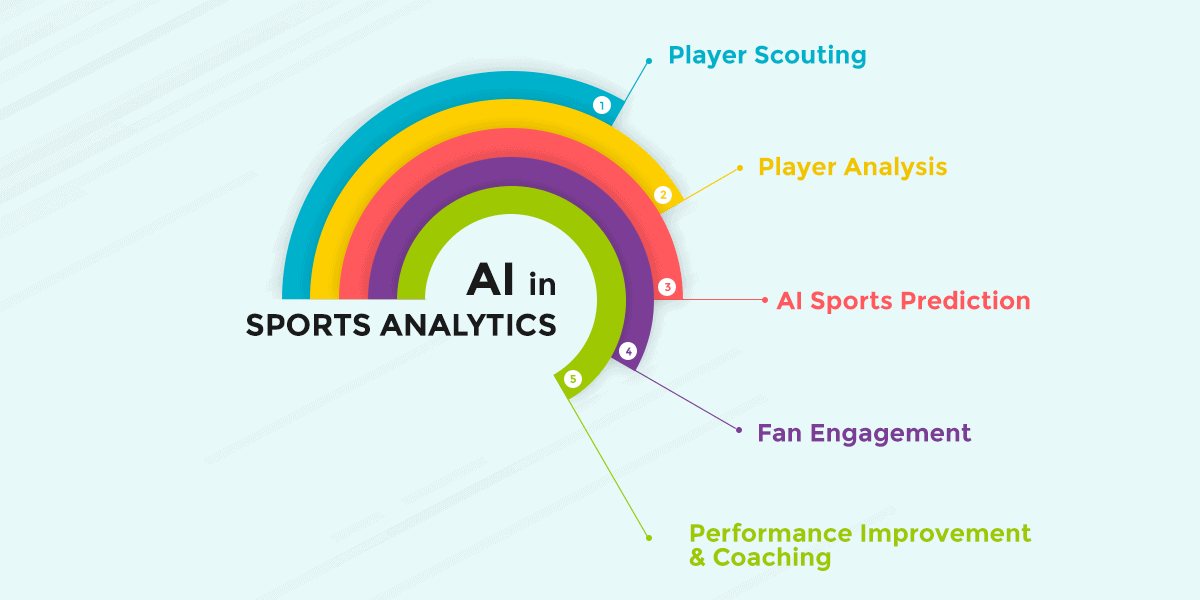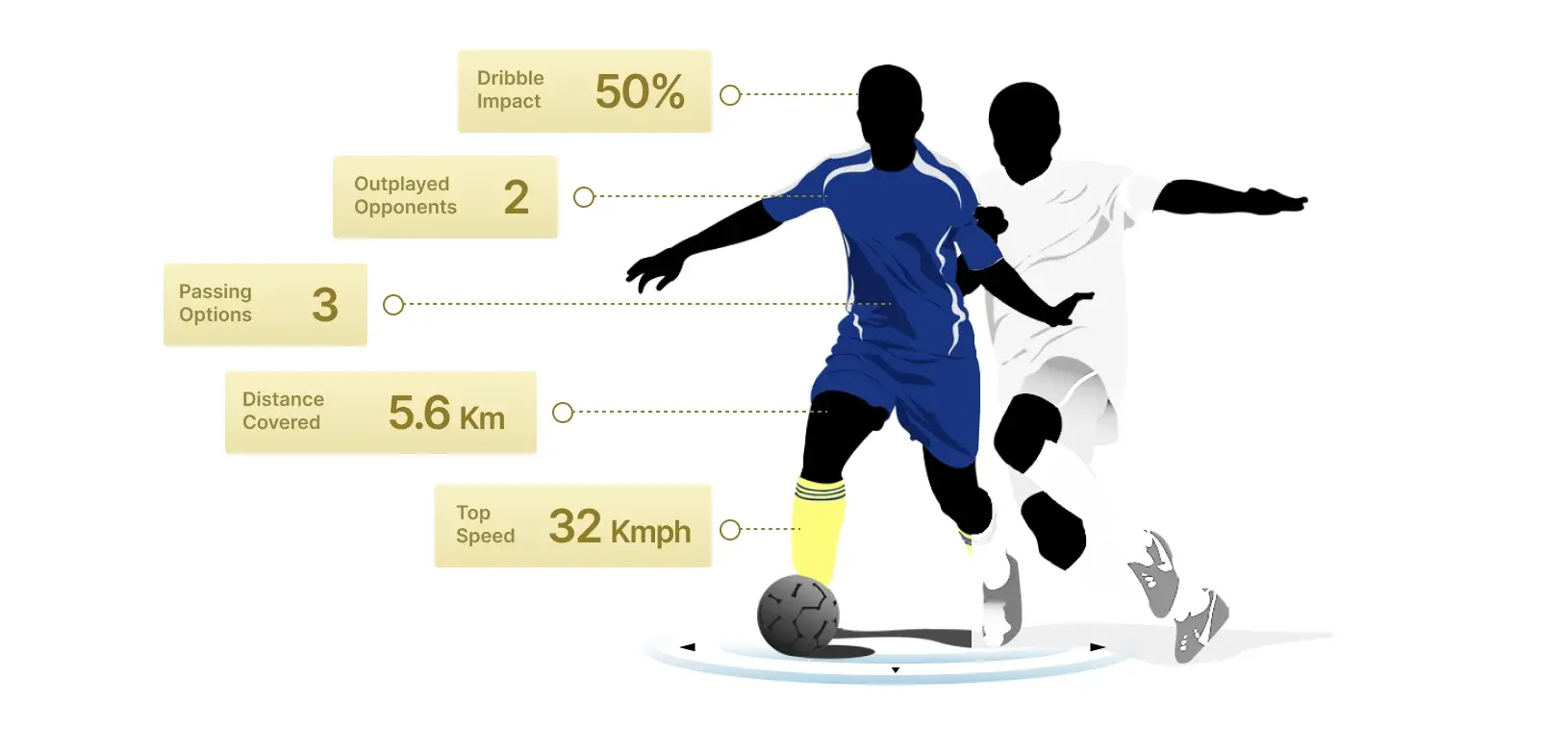Artificial intelligence (AI) has become a revolutionary influence in numerous areas, including the field of sports. AI is transforming the way teams analyze data and make informed decisions, leading to improved athlete performance and revolutionary coaching tactics. This blog examines the significant impact of artificial intelligence (AI) on sports performance statistics, investigating its uses, advantages, and possibilities for future development.
Table of Contents
Comprehending Performance Analytics in Sports
Sports performance analytics is the methodical gathering, examination, and understanding of data pertaining to the performance of athletes. These measures encompass various aspects, including physical traits like velocity and stamina, technical skills like as precision and technique, and tactical awareness encompassing decision-making and placement. Historically, coaches and analysts depended on manual observations and rudimentary statistics. As sports have become increasingly intricate, there has been a greater demand for advanced analytical tools. This is where AI comes in, providing sophisticated capabilities that enable more profound insights and more precise judgments.
The Role of Artificial Intelligence in Data Collection
Wearable Technology
The incorporation of wearable technologies is a major breakthrough in sports performance analytics. Smartwatches, fitness trackers, and specialized sensors are now capable of gathering real-time data on several physiological measurements, such as heart rate, speed, and muscular exhaustion. Artificial intelligence analyzes this data to offer valuable insights regarding an athlete’s performance and overall physical state. Companies such as WHOOP and Catapult Sports have created wearable devices that not only monitor performance indicators but also evaluate recovery patterns and provide ideal training loads. This enables athletes to train more efficiently and reduce the likelihood of getting injured.
Video Examination
AI has also transformed video analysis. AI-driven software may analyze game footage to derive useful data regarding player actions, formations, and strategy. Computer vision algorithms have the capability to monitor and trace the positions of players, recognize recurring patterns, and evaluate the efficiency of particular plays. Hudl and Sportscode are platforms that employ artificial intelligence to analyze game footage, allowing teams to assess their own performance and that of their adversaries. This leads to the development of more knowledgeable game strategy.

Advanced Data Analysis with Artificial Intelligence
Anticipatory Analysis
Predictive modeling is a highly potent implementation of artificial intelligence in the field of sports performance analytics. Through the analysis of historical performance data, artificial intelligence (AI) has the capability to detect patterns and forecast future results, which is particularly valuable for the purpose of preventing injuries. Researchers at the University of Southern California have created an artificial intelligence model that uses multiple performance metrics to forecast the probability of injuries in football players. Coaches can extend athletes’ careers by recognizing players who are at risk and making changes to their training routines and implementing preventive measures.
Immediate and Accurate Observations
AI facilitates real-time analytics during games, offering coaches instantaneous insights into player performance. AI systems have the ability to analyze data in real-time, allowing them to identify important performance indicators and recommend immediate strategic modifications. During a basketball game, artificial intelligence (AI) may assess shooting percentages, defensive matchups, and player fatigue levels in real time. This analysis assists coaches in making educated decisions regarding substitutions, play calls, and defensive plans.
Anticipating and Mitigating Injuries
Identifying Factors that Increase the Likelihood of Risk
Safeguarding against injuries is a paramount concern in the realm of sports, and artificial intelligence (AI) plays a major role in tackling this matter. Through the analysis of extensive data, artificial intelligence (AI) has the capability to detect specific characteristics that increase the likelihood of injuries, such as the intensity of training and the duration required for recuperation. An example of this is the AI system built by the Stanford University Sports Medicine Center, which uses data from wearable devices to forecast injuries in athletes. This enables coaches to modify training intensity and apply specific recuperation techniques.
Customized Training Regimens
Artificial intelligence facilitates the development of customized training regimens that are specifically designed to meet the unique requirements of each athlete. Through the analysis of performance data, artificial intelligence (AI) has the capability to suggest particular workouts, training intensities, and recuperation regimes that are in line with the individual physiology and objectives of each athlete. This individualized technique improves performance while minimizing the likelihood of excessive training and exhaustion, enabling coaches to efficiently optimize training routines.
Optimization of Game Strategy
Examining Patterns of the Adversary
The capacity of AI to examine huge quantities of data extends beyond individual performance to the examination of opponents. Through the analysis of historical data, artificial intelligence (AI) has the ability to discern recurring trends in the playing styles, strengths, and vulnerabilities of adversaries. AI systems have the capability to evaluate shooting trends in basketball opponents, allowing coaches to create defensive methods that take advantage of weaknesses.
Strategic Decision-Making
AI also assists in strategic decision-making during games. Through the analysis of up-to-the-minute data, artificial intelligence has the capability to propose the most advantageous strategies and arrangements, taking into account the present circumstances of the game. AI can assess player placement and movement patterns in soccer to provide suggestions for tactical improvements that can improve efficacy. This enables coaches to make strategic changes that have the potential to greatly influence the outcome of the game.
The future of artificial intelligence (AI) in sports performance analytics is a topic of great interest and potential.
The future of AI in sports performance analytics is hopeful as technology continues to progress. Here are some significant advancements to keep an eye on:
Incorporation of 5G Technology
The implementation of 5G technology will augment the capabilities of artificial intelligence in sports analytics by facilitating expedited data transmission and instantaneous processing, hence enabling more extensive analysis during games and enhanced communication between coaches and players.
Improved Predictive Modeling
With the advancement of AI algorithms, predictive modeling will improve, resulting in increased accuracy. This will allow teams to foresee injuries and performance trends, leading to proactive adjustments in training and game strategy.
Enhanced customization
In the future, it is highly probable that training regimens and performance data will become even more personalized. AI will utilize the increased amount of data gathered from wearables and other sources to deliver customized insights that specifically address the individual requirements and objectives of each athlete.
Ethical Considerations
As artificial intelligence (AI) becomes increasingly important in analyzing sports performance, it is crucial to address ethical concerns related to data privacy, permission, and the potential for misuse of performance data as the sector progresses.

Summary
Artificial intelligence (AI) is revolutionizing sports performance analytics by providing unparalleled insights and capabilities that improve athlete performance, avoid injuries, and optimize game strategy. With the continuous advancement of technology, the integration of AI into sports will become increasingly widespread, profoundly influencing the future in ways that are still not fully comprehended. By utilizing the capabilities of artificial intelligence, teams may make informed decisions based on data to enhance performance and achieve better results. This paves the way for a future in which sports performance analytics is more thrilling and data-focused than ever.



